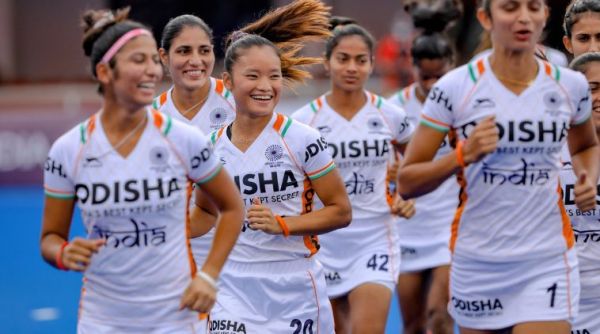Long Read: How a training system common in football is helping India’s women’s hockey team become faster and more accurate
It wasn’t the finish, a close-range tap-in, that pleased Janneke Schopman as much as the build-up.
The move began with a seemingly-harmless pass from Sharmila Devi to Jyoti Gulia on India’s right flank. Jyoti, surrounded by three American defenders, took just one touch to control the ball and with the second, returned it to Sharmila, who had continued her parallel run inside.
Scanning the options in front of her while gliding towards the US ‘D’, the Indian attacker drew two defenders to her, and with her third touch, threaded a through ball towards Vandana Katariya inside the goal-scoring area. Vandana took a couple of steps goal-wards and on cue, Navneet Kaur arrived at the penalty spot to receive the ball and take the move to its intended conclusion.
As the ball thudded into the backboard, Schopman gave all her players in the dugout a high-five. “That’s what I want them to do,” the India coach says. “…see their teammate, decide what they need to do and where to give the ball. I don’t want them to just throw the ball because someone’s asking.”
For months, she’d been trying to instill this kind of telepathic understanding among the players. And after numerous ‘red sessions’ that involve high-intensity training, importing a training technology commonly used in football and countless hours of trying, they nailed it in their penultimate game before the World Cup, where India’s campaign gets underway against England in Amstelveen on Sunday.
This isn’t the sort of the one missing element in the team or something that will magically turn them into a force overnight. It’s, in essence, another building block for a team that’s been punching above its weight and aspires to do that until the giant-killers become giants themselves. (Hockey India)
***
This isn’t the sort of the one missing element in the team or something that will magically turn them into a force overnight. It’s, in essence, another building block for a team that’s been punching above its weight and aspires to do that until the giant-killers become giants themselves.
What made India’s fourth-place finish at the Tokyo Olympics more remarkable is that the team was very much a work in progress back then. Nothing leading up to the Games remotely suggested they would battle their way into the semifinals. But the underdogs defied the odds by riding on the momentum derived from an undying belief among the players and the stubbornness of the then coach, Sjoerd Marijne, to get them to perform better than what they were actually capable of.
In the year since, they’ve shown glimpses of what they are capable of, a case in point being the twin wins over the US, but there’ve been occasions when the team has been handed a reality check as well, like the 5-0 defeat to Belgium a couple of weeks ago. India now stand at a very critical juncture and the coming four weeks will be a trial by fire.
A deep run into the World Cup and the Commonwealth Games will go a long way in enhancing their reputation and giving further thrust to women’s hockey in the country. But Schopman, a two-time Olympic medallist with the Netherlands, including a gold at the Beijing Games, is also conscious that if the performance drops, ‘we will go down very quickly, I am sure’.
***
One of the finest defenders of her generation, Schopman knows the first instinct of her players is to attack.
India have speed in the form of Salima Tete, the skills of Lalremsiami and the combination of Monika, Neha Goyal and Navneet Kaur, who find each other easily and play in triangles to unlock opposition defences. Marijne made these attackers play give-and-go hockey, wherein a player passes the ball to a teammate and continues her forward run to receive a return pass.
Schopman, who was the analytical coach on Marijne’s staff before succeeding him as the chief coach, wants to take the concept forward but has demanded more fluency, higher speed and better accuracy. She is mindful of the fact that against top teams, the players can’t afford to depend on the coach to bark out instructions from the sidelines or delay a pass even by a second. “Good players are able to make decisions in a split-second by themselves,” she says. “So, we have been training specifically to create awareness.”
That meant getting the players to look at each other more often, pre-scan the pitch, play with fewer touches – a maximum of three – and look up all the time to be able to craft a good pass. These may sound very rudimentary aspects but lest one forgets, it wasn’t until five years ago that the women’s team started operating in a professional environment.
For India, who are routinely able to get a result against teams ranked closer to, or below, them, this is paramount to challenge the top guns – the Netherlands, Germanys and Argentinas of world hockey. In the split second between a player looking down to control the ball and lifting her gaze up to spot a teammate and pass the ball, these teams are capable not just of closing down the passing lines but also stealing possession and launching a counter.
 For India, who are routinely able to get a result against teams ranked closer to, or below, them, this is paramount to challenge the top guns – the Netherlands, Germanys and Argentinas of world hockey. (Hockey India)
For India, who are routinely able to get a result against teams ranked closer to, or below, them, this is paramount to challenge the top guns – the Netherlands, Germanys and Argentinas of world hockey. (Hockey India)
Taking the next step
Most of the attacking drills post-Tokyo have centred around making the players operate while looking up and making the right decisions.
In the weeks leading up to the World Cup, the team management even imported a technology, named SmartGoals, to enhance the players’ game intelligence, reaction speed and vision. It’s an interactive system in which light signals, the shape and size of a training cone, are placed as makeshift goalposts.
When a player runs, dribbles, or shoots a ball through them, the light in that smart goal goes off and will jump to another goal.
“So basically, we have to look up all the time to see which goal is lit up and play accordingly,” forward Sangita Kumari says. “We play using four such goals in two teams of four and have to keep the ball moving while trying to spot which goal is open and attack accordingly.”
This is a commonly-used training system in football and the manufacturer’s website lists Dutch clubs Ajax and PSV Eindhoven, Turkish giants Fenerbahce, Bundesliga side Schalke and the Dutch football association, among others, as their clients.
It’s one of the many crossovers between football and hockey, which are perhaps the closest any two sports can get tactically, but Schopman’s purpose of using this tool is clear: “To improve their decision-making and awareness. You’ll hear me saying those two words a lot.”
Sangita, a junior team star who has seamlessly transitioned to the senior level, says the technology has helped them build stamina given the quick switching of the goals, improved reaction speed, and understand how to play while constantly looking up, pre-scan their passing options and enhance their decision-making.
“It’ll be interesting to see if we can do that in a match,” Schopman adds.
That could be a fascinating challenge, given that India will be up against three teams with contrasting playing styles in their first major assignment after the Olympics.
***
India are in Pool B of the 16-team World Cup, alongside England, New Zealand and China. “It’s the group of death. Four good teams…” Schopman says.
Led by goalkeeper Savita Punia, India will open their campaign against England just like at the 2018 World Cup, when the unfancied Indians held the hosts to a hard-fought 1-1 draw in front of 15,000 fans in London.
That result began India’s surge but when the two teams met each other at the Tokyo Olympics twice, including the bronze-medal playoff – England played as Great Britain but a majority of the players remained the same – India lost on both occasions.
“In Tokyo, we didn’t play that well against them,” Schopman says. “Even the girls admitted we just didn’t do enough on the ball… we were just standing. They did something and we didn’t adapt. This time, they said we’ll adapt. Not see the game, but play the game.”
But playing against England, she admits, has been ‘tough’ for her team. England are one of the most dangerous teams while transitioning to attack, which they often do through the middle while committing a lot of numbers forward and using their speed well.
“They have some great attacking players like Lily Owsley and Hannah Martin. They all attack through the middle and if we don’t manage that well, I am sure they will get in our circle way too many times than I would like,” Schopman says. “I know it will depend on how we defend and stay in the play.”
If England play through the centre, New Zealand, Schopman says, like to stretch the field. “For us, it’ll be important to be willing to commit our numbers and not drop with them because if we keep walking backward, we’ll invite these teams to come up. I really want us to be brave and stay higher and put pressure,” she explains. “These two countries are just very good, great attacking transitions, they love big spaces, love to run at teams… that’s something we’ll have to manage.”
It’ll put the spotlight on the defence, which has often looked shaky and rescued by Savita, a proper big-match player.
India have gained an upper hand over China in recent years but to arrest their decline, China pulled off a coup by bringing together two of the sharpest minds in international hockey. They recently appointed Australian great Alyson Annan, who succeeded Marijne as the Dutch women’s team coach and guided them to a stunning Tokyo Olympics gold medal.
After getting Annan on board, China then appointed the legendary Ric Charlesworth as her assistant. And the duo, within no time, has turned China into a team that is extremely tough to crack, as Belgium and the Netherlands experienced in the FIH Pro League last month.
Four years ago, it would have been hard to imagine that India would escape unscathed from such a group. “But we have grown in the last four-five years. Not many took us seriously until then (2017-18),” Savita says. “But now, we are a team that no one would want to play.”
India’s schedule (Pool B, all matches in Amsterdam)
July 3: vs England (8pm)
July 5: vs China (8pm)
July 7: vs New Zealand (11pm)
Format: The pool winners will directly qualify for the quarter-finals. The teams that finish second and third will play cross-over matches from teams that finish in similar positions in other groups.
Squad: Goalkeepers: Savita Punia (C), Bichu Devi Kharibam; Defenders: Deep Grace Ekka (VC), Gurjit Kaur, Nikki Pradhan, Udita; Midfielders: Nisha, Sushila Chanu Pukhrambam, Monika, Neha, Jyoti, Navjot Kaur, Sonika, Salima Tete; Forwards: Vandana Katariya, Lalremsiami, Navneet Kaur, Sharmila Devi; Replacement Players: Akshata Dhekale, Sangita Kumari
